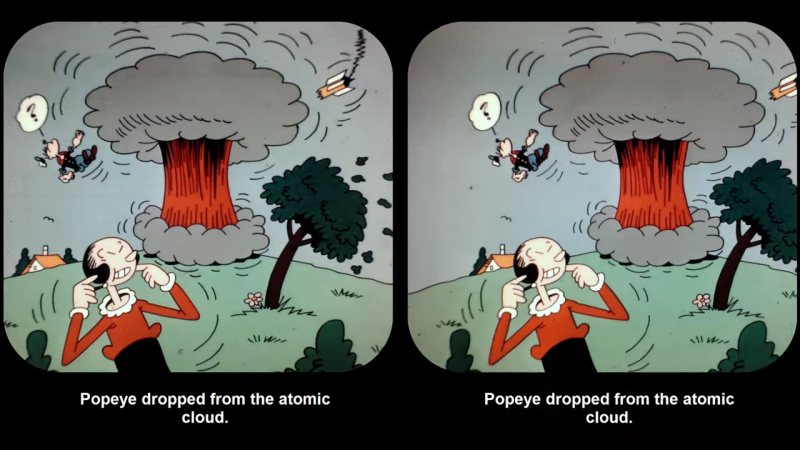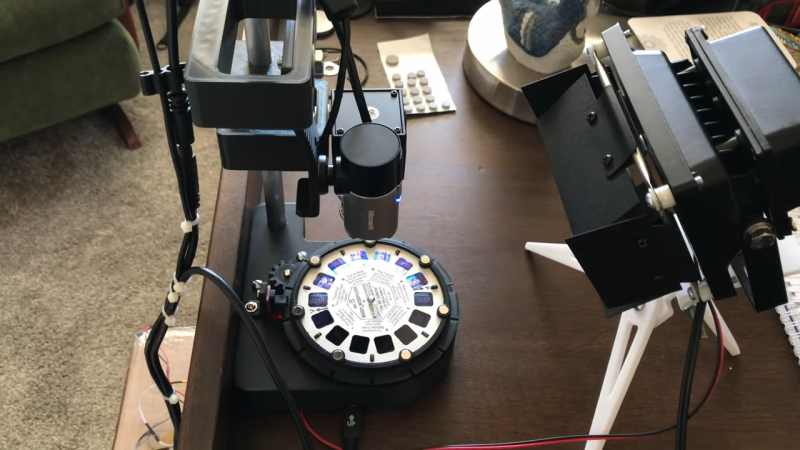The toys of the past may have been cheesy, but you can’t deny the creativity needed to build something engaging without any electronics. One stalwart toy from this category is View-Master, the little stereoscopic slide viewer that brought the world to life in seven vibrant scenes. And digitizing these miniature works of art is the purpose of this neat View-Master reel scanner project.
 If you haven’t had the pleasure of using a View-Master, the gist is that a flat cardboard disc ringed with 14 color transparencies was inserted into a plastic viewer. Binocular eyepieces showed scenes from opposing pairs of slides, which were illuminated by a frosted screen and room lighting. The scenes were photographed from slightly different angles, leading to a stereoscopic image that was actually pretty good quality.
If you haven’t had the pleasure of using a View-Master, the gist is that a flat cardboard disc ringed with 14 color transparencies was inserted into a plastic viewer. Binocular eyepieces showed scenes from opposing pairs of slides, which were illuminated by a frosted screen and room lighting. The scenes were photographed from slightly different angles, leading to a stereoscopic image that was actually pretty good quality.
In the video below, project creator [W. Jason Altice] describes View-Master as “the YouTube of the 1950s.” We partially agree; with only seven frames to tell a story, we’d say it’s more like TikTok than YouTube. Regardless, capturing these mini-movies requires quite a bit of complexity. All the parts for the reel carousel are 3D-printed, with a small stepper to advance the reel and an optical sensor to register its position. A ring of RGB LEDs beneath the reel illuminates the slides; being able to control the color of the light helps with color balancing for slides with faded colors. An 8-megapixel camera captures each slide, and some pretty slick software helps with organizing the image pairs, tweaking their alignment, capturing the captions from the disc, and stitching everything into a video.
There’s a whole YouTube channel devoted to View-Master captures, which are best viewed with a Google Cardboard or something similar. Even without the 3D effect, it’s still pretty cool to watch [Popeye] beat up a nuke again.















So this means we’re like, what, 8 months away from a Two Minute Papers video showing how a researcher took 3D stills from this project and used some bleeding-edge machine learning algorithm to turn them into a fully interpolated 3D movie?
Hold onto your papers, fellow scholars. What a time to be alive!
A good quality flatbed scanner meant for negatives should work quite well also. They have a backlight and can scan a whole glass full of negatives; often the software even has way to specify crop locations to get individual images out of it easily.
But that probably costs more than the parts for this project.
Maybe. I keep an old HP scanner around for stuff like that. Built like a tank.
Getting 8MP out of a such a small frame is not as easy on scanners. Last I looked for one (several years ago) getting 5-10MP across a 35mm negative was typical. Viewmaster slides are much smaller.
Unfortunately that Microsoft webcam doesn’t really work very well either. It may claim 8MP, but the usable pixels aren’t anywhere near that. I have the same camera, and it doesn’t seem to have a zoom, nor is it good at macro shots. It’s passably clear, but my phone camera is better by far.
I too have the same camera and it works pretty great for stills and does have optical (not digital) zoom.
There are two cameras. The Microsoft webcam was just for capturing the entire slide and the text for OCR, it is only 1080p. The 8MP camera was for the slides.
This is the 8MP camera that was used: https://amzn.to/3nCQweB
A friend would record the sound from tv shows, including the episode of The Prisoner where Number Six escapes so most of the episode has no dialogue.
That was the best you could do before videorecorders got cheap enough.
I have “The Penguin Guide to Radio Astronomy”, a pocket sized paperback, from a time when printing them were so cheap that esoteric topics got covered.
It was a different world, not to be explained retroactively, but seen as the fkundation that came later.
Viewmasters weren’t just about 3D. The discs were something we could buy, a permanent record of that trip to Disneyland, or that tv show we liked.
If you didn’t watch a show or movie when it was on, you lost your chance. Maybe it would be repeated, maybe not. So novelizations, comic books, Viewmaster discs, fulfilled a desire that could otherwise only be fulfilled by what was in your memory.
https://en.wikipedia.org/wiki/Stereoscope
I have cards that my great-grandfather kept as souvenirs of his trip to Niagra Falls, etc. Local photographers near all sorts of attractions would sell these to tourists.
Different times!
I was thinking of those.
But that Viewmaster medical series came after the company got the rights to Disney material. And it wasn’t owned by a toy company until 1984.
So “serious” is relative.
“scenes were photographed from slightly different angles”. Slightly different positions. Slightly different angles will make your head split in two.
First thing I did was de-focus my eyes and see the 3d picture…
I had to stick my hand between the two images before I could point my eyes in the right direction to see the 3D image. Once I did, and after a bit of concentration, the image “popped” into 3D, and it appeared about a foot behind the monitor. Once I saw it, I was able to take my hand away and still see it. I was even able to close each eye alternately and notice which image each eye was focused on. Pretty cool. (Note: make sure that the image-spacing is narrower than your inter-pupil spacing, or you’ll never see it right.)
I noticed that the smaller the image pair is, the easier it is to view in this manner, so zoom out as needed.
Exactly what I did too. I zoomed out a bit and did the old magic eye trick.
Neat. Some of those viewmaster disks are pretty old and rare, good to see them archived.
View-Master was originally a high-end teaching and educational tool, including a 23 volume work of detailed dissection views in the Stereoscopic Atlas of Human Anatomy. It was also for travel scenes. It was only later in its life that a toy company got a hold of it and damaged the brand.
It’s nice to see some of the huge volume of quality work that was put into these originally preserved and transferred.
Impressive. Well done.
This is a cute solution to the problem of scanning VM slides. All of the diorama View-Master reels have been scanned and restored by me using a flatbed scanner, Stereo Photo Maker and various software to correct the color and refocus the images. They are available as side-by-side anamorphic images in a video with YouTube metadata which allows them to be seen on some digital 3D devices. The restoration has been done to 2k+ resolution, but that is not fully available on YouTube. When available the text of the booklets has been included. In particular the Dracula and Wolfman dioramas have been very well color corrected. A few of the cartoon reels are also available with corrected color balance, along with some of the classic scenics.
I compliment the creator on an effective project that gives great output ! I hope he will make the 3D model files available – it’s tempting to try it.
Some comments : others have suggested using a flatbed scanner and taking the whole reel at once : if you do, Photoshop has a feature that will find the individual chips in the composite and crop them into separate images. Doesn’t always work perfectly, but worth a try.
For those working with pairs of 3D images : there is a great (and free !) software for working with 3D stereo pairs : Stereo Photo Maker : available at : http://stereo.jpn.org/eng/stphmkr/
This software can automatically align the two images, color correct them to match, crop as a pair to match, auto rescale as a pair, copy / paste from one image to the other (for spot removal, etc); and almost any other desired transformation with the benefit of doing both images simultaneously as a matched set.
SPM is the most commonly used software by modern stereophotographers in the National Stereoscopic Association (at http://www.stereoview.org/ ) for a reason : it’s that good !
I look forward to having more viewmaster reels saved for modern users.
Thanks
Bill
Thanks for the links!
Here are the 3D files.
https://github.com/CodeMakesItGo/View-Remaster
I think the reverse process would be much more interesting. Turn that animated gif into a viewmaster disk. Is it even possible to produce film positives these days or have they stopped production of the film?
The ViewMaster discs I had, had a metal layer inside. I assume to make them resistant to accidental bending and also ensure the indexing slots didn’t get worn.
I have many personal family Viewmaster reels that my husband took with his own 3D camera in the 50s and 60s. I would like to retreive some as simple digitized still shots. Most, of course have faded but still valuable as family memories. I only have basic skills. Also have some commercial reels from vacations.